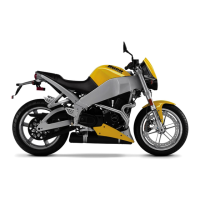
Do you have a question about the Buell XB9S 2003 and is the answer not in the manual?
| Year | 2003 |
|---|---|
| Manufacturer | Buell |
| Model | XB9S |
| Category | Motorcycle |
| Displacement | 984 cc |
| Bore x Stroke | 88.9 mm x 79.4 mm |
| Compression Ratio | 10.0:1 |
| Ignition | Electronic |
| Transmission | 5-speed |
| Final Drive | Belt |
| Front Brakes | Single 375 mm disc, 6-piston caliper |
| Front Tire | 120/70-ZR17 |
| Rear Tire | 180/55-ZR17 |
| Engine Type | Air-cooled, 4-stroke, 45° V-Twin |
| Torque | 85 Nm @ 5500 RPM |
| Frame | Aluminum frame |
| Front Suspension | Showa 41 mm inverted fork |
| Rear Suspension | Showa shock, adjustable preload, compression and rebound damping |
| Rear Brakes | Single-piston caliper |
| Wheelbase | 1321 mm (52.0 inches) |
| Dry Weight | 175 kg |
Essential checks for safe motorcycle operation and rider welfare.
Covers repair definitions, general safety, part removal, and cleaning for workshop practices.
Procedures for installing thread inserts and replacing common hardware and fittings.
Guidelines for replacing hoses, wiring, electrical switches, and fuel lines.
Procedures for handling, cleaning, and replacing bearings, bushings, seals, and O-rings.
Checks for gear damage, shaft removal, and inspection of tapered splines.
Protecting parts and methods for thorough cleaning, including rust removal.
Safety guidelines for operating various tools like air tools, wrenches, hammers, and screwdrivers.
Recommendations for using quality gasoline, avoiding alcohol additives, and understanding blends.
Proper engine oil grades, viscosity, and considerations for cold weather operation.
Table detailing service operations and intervals based on odometer readings.
Procedures for washing, cleaning between washes, and maintaining the gloss of body panels.
Steps for polishing, applying sealant, and removing minor scratches from body panels.
Information on battery type, inspection, and voltmeter testing procedures.
Procedures for cleaning battery tops, terminals, and inspecting for damage.
Recommendations for storing batteries, including charging and temperature considerations.
Step-by-step guide for placing the battery, connecting cables, and securing it.
Procedures for checking engine oil level at operating temperature, including dipstick use.
Instructions for draining engine oil using the drain plug.
Steps for removing and replacing the engine oil filter, including lubrication.
Procedures for filling the oil tank, inspecting the dipstick o-ring, and checking the oil cooler.
Table showing recommended oil grades based on viscosity and ambient temperature.
Procedures for checking brake fluid, replacing DOT 4 fluid, and inspecting lines and seals.
Safety warnings and procedures for bleeding brake systems, emphasizing fluid compatibility.
Step-by-step guide for bleeding the front brake caliper and master cylinder.
Step-by-step guide for bleeding the rear brake caliper and master cylinder.
Procedures for checking brake pedal operation and adjusting its height.
How to check brake pad minimum thickness and when to replace them.
Procedures for measuring rotor thickness and checking rotor surface for damage.
Step-by-step guide for removing front brake pads.
Step-by-step guide for installing new front brake pads.
Step-by-step guide for removing rear brake pads.
Step-by-step guide for installing new rear brake pads.
Guidelines for checking tire pressure and tread wear indicators.
Criteria indicating when new tires are needed.
Procedures for checking and replacing wheel bearings for wear and corrosion.
Procedures for checking and replacing transmission fluid, including capacity.
Step-by-step guide for adjusting clutch cable and mechanism for proper free play.
Procedures for inspecting the drive belt for wear patterns and the idler pulley.
Guidelines for cleaning the drive belt with mild soap and water.
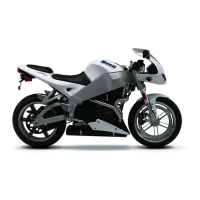
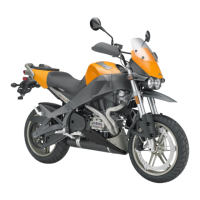
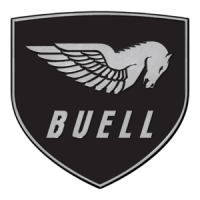

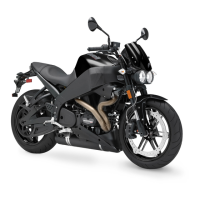

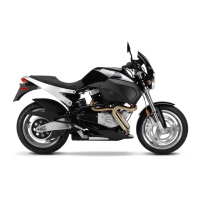
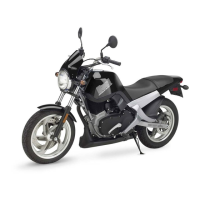
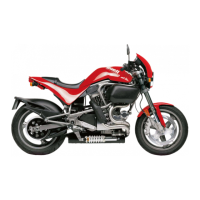
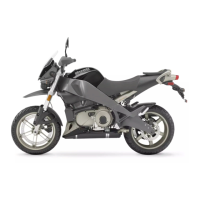
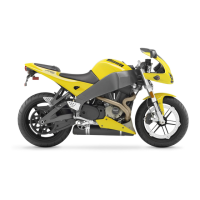
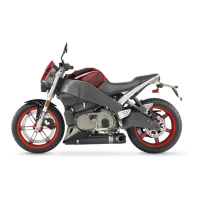
